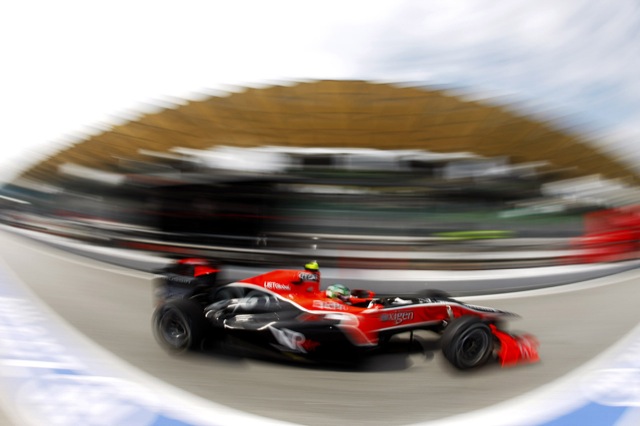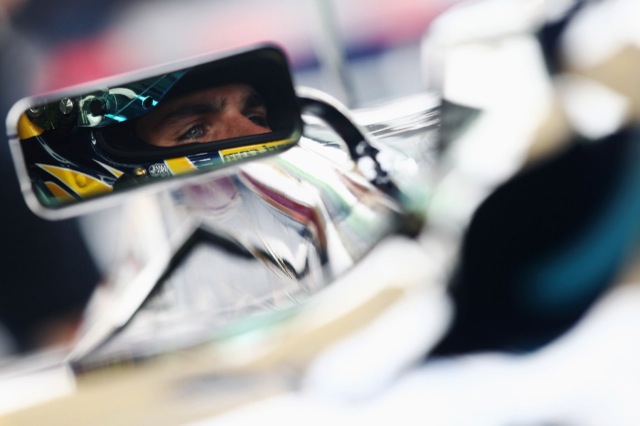The FIA have published the weights of the top ten in qualifying earlier and the declared weights of the bottom half of the grid ahead of tomorrow’s European Grand Prix. From this, we can estimate the first pitstop of all the runners by taking Williams’s 5km-normalised fuel consumption for Valencia of 2.45kg. This means the 5.419km lap will use up 2.65531kg of fuel, and less a couple of laps for grid forming and margin, we can see who did well in qualifying, and who needs to do better.
Lewis Hamilton was indeed lighter than Heikki Kovalainen, which is a standard McLaren tactic. However, what is perhaps slightly surprising is that there wasn’t a lot of difference in it. Kovalainen has just one extra lap of fuel on board, indicating that until the Finn messed up his final run in Q3, he was actually setting very competitive times. Both McLaren pilots are on a similar strategy and will stop around the lap 16 mark.
Brawn too are opting for a same strategy for both drivers, with Jenson Button taking the lighter of the two. Unfortunately for the Briton, team mate Rubens Barrichello out-qualified him on a heavy fuel load, suggesting Button was not as keyed-in to Valencia on Saturday than the Brazilian. Both will stay out longer than the McLarens, which means that if they can keep up with the silver cars for the opening stint, they look good for a decent result. If the KERS-enabled MP4-24s power away though, it will be over relatively quickly.
Red Bull Racing have split their strategies slightly, with Sebastian Vettel stopping around the same time as the McLarens, and Mark Webber stopping around the same time as the Brawns. It is interesting to compare the cars of Vettel and Hamilton, as each had similar fuel loads, but the RB5 was 0.3s slower, proving just how much the McLaren team have improved their car.
The lightest drivers on the grid are Hamilton and Vettel, and Robert Kubica has opted for a fairly aggressive strategy as well, aiming for lap 18 for his first stop. The heaviest cars out there on race morning will be Jarno Trulli, who can theoretically go until lap 37 before stopping, and Kazuki Nakajima who can last until lap 35. Toyota aren’t afraid of running ridiculously long into stints, and while sometimes it works, it doesn’t always prove successful. Although as Trulli qualified in P18, I guess there’s no harm in trying something a little radical.
Valencia 2009
|
Car Weight
|
Fuel Weight
|
First Stop
|
|
| 1. | 653 | 42.7 | 16 | |
| 2. | 655 | 44.7 | 17 | |
| 3. | 662.5 | 52.2 | 20 | |
| 4. | 654 | 43.7 | 16 | |
| 5. | 661.5 | 51.2 | 19 | |
| 6. | 661.5 | 51.2 | 19 | |
| 7. | 665 | 54.7 | 21 | |
| 8. | 656.5 | 49.5 | 19 | |
| 9. | 664.5 | 54.2 | 20 | |
| 10. | 657.5 | 47.2 | 18 | |
| 11. | 677 | 66.7 | 25 | |
| 12. | 672.5 | 62.2 | 23 | |
| 13. | 694.7 | 84.4 | 32 | |
| 14. | 677.7 | 67.4 | 25 | |
| 15. | 688.5 | 78.2 | 29 | |
| 16. | 692.5 | 82.2 | 31 | |
| 17. | 702 | 91.7 | 35 | |
| 18. | 707.3 | 97 | 37 | |
| 19. | 678.5 | 68.2 | 26 | |
| 20. | 690.5 | 80.2 | 30 | |


















Add comment